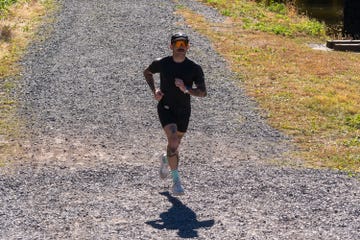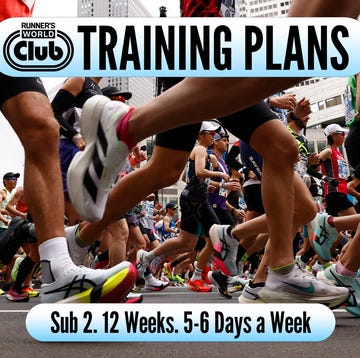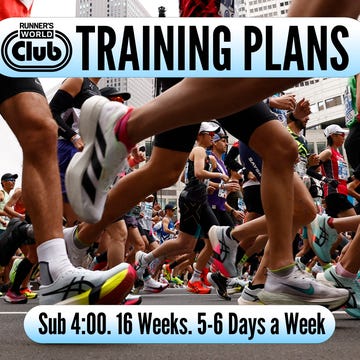Regardless of your age, preferred running distance or general running ability, you can benefit from working on your speed during training. Even better, you don’t even need to plan major interval training sessions to get faster.
Although speedwork is obviously key when preparing for shorter events such as the 800m, the mile or the 5K, it can also help with your marathon or ultramarathon training. Essentially, speedwork is all about pushing your body beyond the point where it feels comfortable, which gives a controllable dose of stress and training stimulus to help you to adapt to a higher level of fitness.
This guide will help you to learn how to run faster.
What everyone's reading
What are the benefits of speedwork training?
Cardiovascular
Higher-intensity training can increase your stroke volume (which is the amount of blood that your heart can pump with each beat), your production of myoglobin (which transports oxygen to your muscles), your blood volume (which means that more oxygen can be carried to your muscles) and your muscles’ ability to absorb that oxygen to create energy. Speedwork can also improve your body’s ability to tolerate and process lactate.
Mechanical
If you run fast regularly, you can improve your running economy across a range of speeds, which means that you can do more work for the same amount of oxygen. This is a result of improved running mechanics, ground contact times and tendon stiffness, among various other factors.
Neural
High-intensity speed training delivers a powerful stimulus to your nervous system. When paired with proper rest periods, it also helps to build greater endurance for distance running by increasing your body’s resistance to exhaustion.
Psychological
To get that PB, it’s not just a matter of your body running faster – your brain has to be in agreement with the process as well. When we push ourselves beyond our limits, sometimes our minds will talk us down and make it feel even harder. Doing regular speedwork will give you the physical and mental proof of your extended capabilities, providing the ‘callusing’ that is required to run well on race day.
Speedwork principles
First, here are some general principles that should form the foundations of any speedwork training programme. Once you’ve digested these, we’ll get more specific.
Structure your sessions
You can include faster running in your training plan in a range of different ways – take fartlek sessions, tempo runs and interval sessions, for example.
Speedwork typically involves running at paces that match or exceed your target race tempo. This type of training is most often structured as interval workouts, which is a systematic combination of high-speed segments that alternate with designated recovery periods. This format lets you carefully control your training intensity while gradually increasing your proficiency.
Balance speed with steadiness
It’s important not to assume that doing more fast sessions means that you can skip the slower ones – especially if you’re lacking free time in your week. To become faster, you still need a mix of quality and quantity in your running routine. So, don’t forget to tick off a good amount of easy and steady runs, too.
Start general, then become specific
There are many speedwork sessions out there, so you’ll want to pick routines that suit the distance that you’re aiming for in an upcoming race. In the early stages, you should work on more general conditioning, then gradually focus more on your goal race as you get nearer to the big day. As it approaches, you should be spending more time running at your target race pace.
Be patient
It’s natural to want to see quick improvements when you commit to a training plan. However, the plan that we’ve providing below is a long journey that last for 18 to 24 weeks – a full process that builds gradually toward your fastest 5K. You’ll need commitment and focus, but we promise that it’ll be worth it.
Control the variables
If you manipulate the effort at which you run your fast efforts (the intensity), the length and type of recovery between each effort (the interval), the number of efforts that you complete and the conditions that you face, you can change the outcome and stimulus of the sessions. Be creative, but remember what you are trying to achieve.
Manageable amounts
Ramping up speed training doesn’t automatically translate to better performance. The key lies in balancing intense workouts with adequate rest periods and lighter training days. For most runners, incorporating one or two fast-paced sessions into a week is enough to achieve the adaptations that they need.
Before you start
Your speed sessions shouldn’t neglect the need for a decent warm-up, as well as a proper cooldown afterward. Warm-ups help to keep you injury-free and allow you to activate your joints and muscles and gradually increase your heart rate before you get going. That way, you can perform more effectively at the required intensity.
Be consistent
Many runners fall into the trap of treating speed training as an extreme test of their limits. Instead of pushing yourself to exhaustion or treating each session as a personal challenge, focus on maintaining your target pace. This disciplined approach leads to more reliable performance and, over time, superior fitness gains.
Power up
Regular strength training can improve your ability to generate force and control any technique changes that you wish to make, like running with a longer stride to sustain a higher cadence when you’re tired. In particular, your tendons can provide a substantial amount of propulsion through elastic energy. You can improve the stretch-reflex function of your tendons by completing plyometric exercises, such as the pogo jump, hopping and bounding exercises, once or twice a week.
How to run a faster 5K
Building speed can be seen as a process. First, you develop basic, fundamental speed, then you progress to work on race-specific speed that will help you to set your next PB. To illustrate this in practice, I will talk you through a three-stage plan to help you run a faster 5K. Similar principles can also be applied to other race distances, too.
Part 1: Lay the foundation
In truth, most of the sessions that we refer to as speedwork – such as mile efforts, fartlek sessions or even 400m repetitions – are actually more about endurance. The foundations of speed actually come from much shorter and faster efforts that require focused training. In stage one, you work on your neuromuscular system, tendons and other connective tissues to develop reactive force and good running technique. This will provide the foundation on which to build faster, more race-specific sessions down the line. The first few weeks are focused on these fundamentals.
Sessions to complete over a six-to-eight-week period:
- SESSION 1: 4 x 8-10-second hill sprints with a two-minute rest.
- SESSION 2: 6 x 8-10-second hill sprints with a two-minute rest.
- SESSION 3: 8 x 8-10-second hill sprints with a two-minute rest.
- SESSION 4: 4 x 8-10-second hill sprints with a two-minute rest, plus 2 x 120m at 400m/800m pace on flat ground, with a three-minute rest.
- SESSION 5: 5 x 60m/80m sprints on flat ground with a two-minute rest, plus 2 x 150m at 400m/800m pace on flat ground, with a two-minute rest.
- SESSION 6: 6 x 8-10-second hill sprints with a two-minute rest, plus 2 x 200m at a fast pace on flat ground, with a two- or three-minute rest.
- SESSION 7: 2 x 60m, 2 x 100m, 150m and 200m at a fast pace, all with a three- or four-minute rest.
- SESSION 8: 5 x 150m at 800m pace with a three- or four-minute rest.
Sprint for success
The foundations of speed require fast running. When we sprint or run near our sprinting speed, we teach our body to recruit more fast-twitch muscle fibres, we stress our central nervous system and we learn to run with better mechanics.
Maximum quality in the shortest time
Running at maximal speed or near maximal speed is heavily reliant on your fast ATP-CP energy system. This provides immediate energy through the breakdown of stored high-energy phosphates for near or maximal intensity, short duration exercise before it fatigues. It will also take a significant amount of time to ‘recharge’. In practice, that means focusing on short efforts of eight to 10 seconds with a recovery of around two minutes. Start with a small number of efforts – perhaps four – and run just a little off your maximum sprinting speed (at around 95% or a 400m effort). Imagine making every stride the highest quality that you can achieve.
Hills to help
Many distance runners struggle to generate the speed required to get the benefit of these short, fast efforts. Consider starting on a hill with a moderate gradient, remembering that you still need to be able to run fast. We tend to run with better mechanical form on hills, so it’s a great way to build up speed and ensure that you are recruiting those fast-twitch muscle fibres. Progress these sessions to fast running on the flat when you feel conditioned.
Relaxed speed
Watch videos of Usain Bolt run and you’ll realise that speed doesn’t come out of trying to force pace. Relaxed speed should be your aim. The goal isn’t just to produce fast running – it is to do it well.
Conditioning
Your strength training during this period should include key strength exercises, such as split squats, deadlifts, hip thrusts and lunges. Plyometrics and drills can also be included, but, once again, the intensity should be moderate – learning the correct technique is key here.
The wider plan
During this foundation phase, your body needs time between these high-intensity efforts. Aim to include good volumes of easy running and try to peak your mileage toward the end of this six-to-eight-week block. Also, aim to gradually build up to a long run of 75 to 90 minutes and consider running on undulating and off-road routes.
Endurance balance
While the sessions above are focused on speed, it’s good to still do some endurance-focused sessions in this period. For the 5K, this might be a weekly run that progresses to marathon pace or a little faster for the final 10 to 20 minutes.
Part 2: Extend your speed
On completing stage one, you should be better able to recruit fast-twitch muscle fibres and know the feeling of running fast. Stage two extends this speed to make it more specific to the race that you’re training for.
Sessions to complete over a six-to-eight week period:
- SESSION 1: 8-10 x 200m (or 40 seconds) at 1500m/3km pace with a 200m jog recovery.
- SESSION 2: 8 x 300m (or 75-90 seconds) at 3km pace with a 90-120-second rest.
- SESSION 3: 6 x 8-10-second hills repeats, plus 2 x 200m at a fast pace on flat ground, with a two-minute rest.
- SESSION 4: 1km, 800m, 600m and 400m with a five- or six-minute rest. Run the 1km and 800m at 3km pace, then aim to get faster on the 600m and 400m efforts.
- SESSION 5: 8 x 400m (or 75-90 seconds) at 3km pace with a 90-120-second rest.
- SESSION 6: 4 x 2 minutes at 3km pace with a three-minute rest, plus 5 x 8- 10-second hill repeats, with a two-minute rest.
- SESSION 7: 2 x 600m, 400m, 300m, 200m and 100m with a three- or four-minute rest, starting at 5K pace and working down to 800m pace.
- SESSION 8: 5 x 2 minutes with the first two minutes at goal 5K pace, then the next three minutes at 3km pace, with a two- or three-minute rest.
Shift the dials
In stage two, your speed sessions move primarily toward the flat. While still fast, the efforts drop in pace and increase in volume, with a shorter effort-to-recovery ratio. As we drop the recovery compared with the level of effort, we put a greater focus on your aerobic and lactic energy systems, which help you to power endurance.
Support network
Stage two’s speed sessions are designed to lead you into the 5K pace sessions in stage three. These runs at between 1500m and 5K pace will help to make those bigger sessions feel more manageable.
The wider plan
Still include easy and steady running in routine, but consider dropping the volume by 10% or even 20% as the emphasis shifts to bigger sessions.
Find your threshold
Threshold sessions – which are run at a ‘comfortably hard’ pace that you could hold for an hour – such as 4 x 6 minutes, 3 x 8 minutes, 5 x 5 minutes and 6 x 5 minutes, with 60- or 90-second recoveries in between, will build your endurance for the 5K.
Conditioning
With your movement patterns established, small increases in weights provide a good platform for stage three. Can’t get to the gym? Circuits with bodyweight exercises also work well.
Part 3: Get race ready
Stage three involves spending more time working around your goal 5K race pace – and to build endurance, it includes longer efforts with shorter recoveries. This puts a greater emphasis on stressing your aerobic system, which provides the vast majority of the energy required for a 5K race.
Sessions to complete over a six-to-eight-week period:
- SESSION 1: Five minutes at 60-minute race pace, plus two sets of 5 x 75-90 seconds at 5K pace, with a 60-second rest between efforts and a two-minute rest between sets.
- SESSION 2: 8 x 2 minutes at 5K pace with a 90-second recovery.
- SESSION 3: Five minutes, four minutes, three minutes, two minutes and one minute with a 90-second rest. Start at 60-minute race pace and work down to 3km pace.
- SESSION 4: Three sets of 5 x 75-90 seconds at 5K pace with a 30-45-second rest between efforts and a two-minute rest between sets.
- SESSION 5: 10 x 2 minutes at 5K pace with a 75-90-second rest.
- SESSION 6: 5 x 4 minutes at 5K pace with a 60-second rest, plus 75 seconds at 3km pace, with a two-minute rest.
- SESSION 7: Five minutes at threshold effort, plus 5-6 x 1km at 5K pace, with a 90-120-second rest.
- SESSION 8: 3 x 1km at 5K pace with a 90-second rest, plus 4 x 500m at 3km pace with a 90-second rest, plus a 1km time trial.
The wider plan
Keep your volume in check with a long run, but reduce this slightly from what you did in stage one. Make sure that you are controlling the pace of your easy runs to guarantee that you are fresh for the bigger speed sessions in this stage.
Blend it in
Maintaining some of the endurance work from the stage two is important. Sessions such as 5 x 5 minutes might start at one-hour race pace, then work down to 10K race pace by the end of your training block. You can also consider adding some longer endurance efforts to the start or end of your key sessions at 5K race pace.
Conditioning
In this final period of training, take care with the load of your strength sessions. Perhaps reduce the number of repetitions in sets to ensure that you are not fatigued for your key run sessions.
Maintenance work
Consider adding a handful of strides or short hills – like 4 x 8-10 seconds – after one of your easy runs each week.













